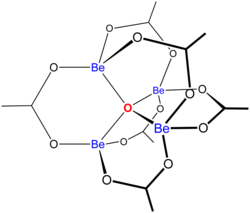 | |
| Names | |
|---|---|
| Systematic IUPAC name Hexa-μ-acetato(O,O')-μ4-oxo-tetraberyllium(II) | |
| Other names Beryllium oxyacetate Beryllium oxide acetate Basic beryllium acetate | |
| Identifiers | |
3D model (JSmol) | |
| ChemSpider | |
| ECHA InfoCard | 100.038.881 |
| EC Number |
|
PubChem CID | |
| UNII | |
CompTox Dashboard (EPA) | |
| |
| |
| Properties | |
| C 12H 18Be 4O 13 | |
| Molar mass | 406.3122 g/mol |
| Appearance | colorless |
| Melting point | 285 °C (545 °F; 558 K) |
| Boiling point | 330 °C (626 °F; 603 K) |
| Solubility in chloroform | soluble |
| Hazards | |
| Occupational safety and health (OHS/OSH): | |
Main hazards | highly toxic |
| GHS labelling: | |
    | |
| Danger | |
| H301, H315, H317, H319, H330, H335, H350, H372, H411 | |
| P203, P260, P261, P264, P264+P265, P270, P271, P272, P273, P280, P284, P301+P316, P302+P352, P304+P340, P305+P351+P338, P316, P318, P319, P320, P321, P330, P332+P317, P333+P317, P337+P317, P362+P364, P391, P403+P233, P405, P501 | |
| NIOSH (US health exposure limits): | |
PEL (Permissible) | TWA 0.002 mg/m3 C 0.005 mg/m3 (30 minutes), with a maximum peak of 0.025 mg/m3 (as Be) [1] |
REL (Recommended) | Ca C 0.0005 mg/m3 (as Be) [1] |
IDLH (Immediate danger) | Ca [4 mg/m3 (as Be)] [1] |
Except where otherwise noted, data are given for materials in their standard state (at 25 °C [77 °F], 100 kPa). | |
Basic beryllium acetate is the chemical compound with the formula Be4O(O2CCH3)6. This compound adopts a distinctive structure, but it has no applications and has been only lightly studied. It is a colourless solid that is soluble in organic solvents.
